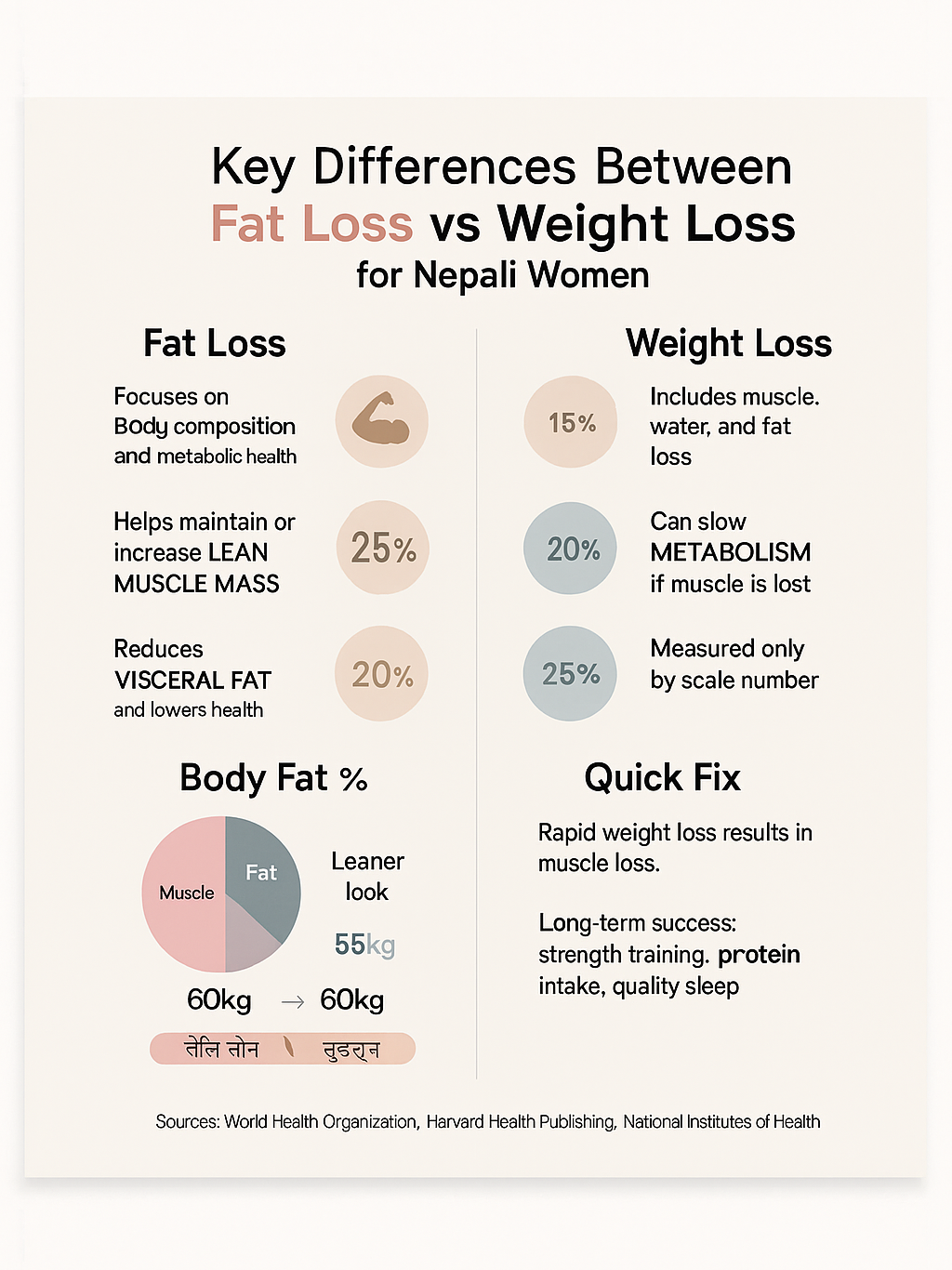Introduction: Why the Scale Isn’t the Full Story

For many Nepali women—especially in cities like Kathmandu, Pokhara, and Bharatpur—the number on the scale often becomes a daily obsession. But here’s a truth most fitness coaches don’t share: losing weight and losing fat are not the same thing.
As a certified fitness coach with over 15 years of experience helping women across Nepal, I’ve seen it time and again: a woman drops 5 kilos but still feels “soft” or tired. Why? Because she lost muscle, not fat.
In this guide, you’ll learn:
- The key differences between fat loss and weight loss
- Why fat loss is healthier and more sustainable
- How to measure real progress (beyond the scale)
- Nepal-specific tips for nutrition and exercise
Fat Loss vs Weight Loss: Key Differences
| Fat Loss | Weight Loss |
|---|---|
| Definition | Reducing body fat while maintaining or gaining muscle |
| Goal | Improve body composition, metabolic health |
| Results | Leaner, stronger appearance |
| Sustainability | Long-term, health-focused |
| Best Measured By | Body fat %, how clothes fit, energy levels |
Why Fat Loss is the Healthier Choice for Nepali Women
Fat loss is more sustainable, especially for Nepali women whose diets often include high carbohydrates (dal bhat, chiura) but are low in protein. Maintaining lean muscle helps with:
- Boosting metabolism (muscle burns more calories than fat at rest)
- Balancing hormones (especially after menopause or childbirth)
- Daily strength (carrying groceries, walking hills, lifting children)
- Reducing risk of chronic diseases (supported by World Health Organization data)
Want to learn more?
Best Exercises to Reduce Belly Fat for Women in Nepal
Muscle vs Scale Weight: Why It Matters
Did you know? One kilo of fat takes up more space than one kilo of muscle.
That means you can look leaner and feel stronger—even if the scale doesn’t move.
Example:
Two women both weigh 60 kg.
- One has 30% body fat, the other has 20%.
- The second woman will look visibly leaner and feel stronger, even though they weigh the same.
Nepali Tip: Focus on how your clothes fit or take monthly progress photos. Don’t rely on your bathroom scale alone.
Signs You’re Losing Fat (Not Just Weight)
- Waist measurements are shrinking
- Clothes fit better around hips/thighs
- You’re stronger in bodyweight or resistance exercises
- Your face looks more defined
- Energy levels and sleep are improving
How to Prioritize Fat Loss in Nepal
1. Eat Enough Protein
Most Nepali meals are carb-heavy. To preserve muscle while losing fat, aim for:
- 1.2–1.6g of protein per kg body weight
- Include protein-rich foods: dal, chana, paneer, chicken, fish, eggs
- Consider whey protein—explore clean options from local brands or MyProtein Nepal partners
Related: Strength Training Guide for Nepali Women
2. Lift Weights or Do Resistance Training
Cardio alone can lead to muscle loss. To lose fat and stay strong:
- Try bodyweight squats, pushups, lunges
- Use resistance bands (affordable and portable)
- Use dumbbells at gyms in Kathmandu, Pokhara, or Lalitpur
Recommended: Affordable Resistance Bands in Nepal
3. Don’t Overdo Cardio
While Zone 2 cardio helps burn fat, too much can reduce muscle.
- Ideal mix: 2–3 days strength training + 2 days cardio + 1–2 days active recovery (walk, stretch, yoga)
4. Sleep and Stress Matter
Poor sleep and stress raise cortisol, which promotes belly fat.
- Aim for 7–9 hours of sleep
- Avoid caffeine after 4 PM
- Practice breathing, or walk in calming areas like Swayambhunath or Lakeside
5. Track Progress Beyond the Scale
- Tape measurements (waist, hips, thighs)
- Monthly progress photos
- How your jeans or kurta fit
- Strength improvements (e.g., more pushups)
Debunking Weight Loss Myths
Myth 1: Sweating = Fat Loss
Fact: Sweating is just fluid loss. You regain the weight after drinking water.
Myth 2: Fasted workouts burn more fat
Fact: You may burn fat, but also muscle if protein is too low or intensity is too high.
Myth 3: You must avoid all carbs
Fact: Dal bhat can be part of a fat loss plan—just watch your portion and balance it with protein and vegetables.
Final Thoughts: Chase Strength, Not Just the Scale
Fat loss—not just weight loss—is what creates lasting health and a toned, strong body. For Nepali women, shifting your focus from the scale to body composition is empowering.
Start strength training, eat with purpose, and track how you feel—not just what you weigh.
Explore more transformation-focused guides:
Postpartum Workout Guide for Nepali Women

